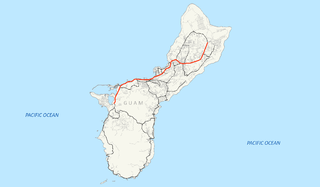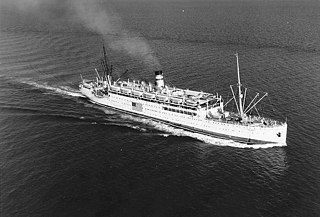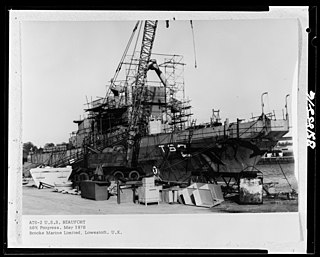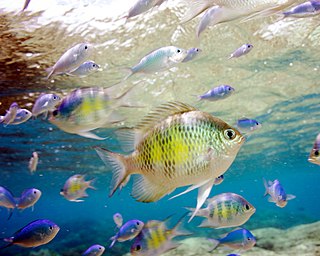
Guam is a U.S. territory in the western Pacific Ocean, at the boundary of the Philippine Sea. It is the southernmost and largest member of the Mariana Islands archipelago, which is itself the northernmost group of islands in Micronesia. The closest political entity is the Commonwealth of the Northern Mariana Islands (CNMI), another U.S. territory. Guam shares maritime boundaries with CNMI to the north and the Federated States of Micronesia to the south. It is located approximately one quarter of the way from the Philippines to Hawaii. Its location and size make it strategically important. It is the only island with both a protected harbor and land for multiple airports between Asia and Hawaii, on an east–west axis, and between Papua New Guinea and Japan, on a north–south axis.

Apra Harbor, also called Port Apra, is a deep-water port on the western side of the United States territory of Guam. It is considered one of the best natural ports in the Pacific Ocean. The harbor is bounded by Cabras Island and the Glass Breakwater to the north and the Orote Peninsula in the south. Naval Base Guam and the Port of Guam are the two major users of the harbor. It is also a popular recreation area for boaters, surfers, scuba divers, and other recreationalists.

The Capture of Guam was a bloodless engagement between the United States and Spain during the Spanish–American War. The U.S. Navy sent a single cruiser, USS Charleston, to capture the island of Guam, which was under Spanish control. However, the Spanish garrison on the island had no knowledge of the war and no real ability to resist the American forces. They surrendered without resistance, and the island passed into American control. The event was the only conflict of the Spanish–American War on Guam.

Piti is a village located on the central west coast of the United States territory of Guam. It contains northern and eastern coastlines of Apra Harbor, including Cabras Island, which has the commercial Port of Guam and the island's largest power plants. Piti was a pre-Spanish CHamoru village and, after Spanish colonization, became the primary port town on Guam. The town was largely destroyed during the 1944 liberation of Guam and the population relocated during the wartime construction of Apra Harbor.

Guam Highway 1 (GH-1), also known as Marine Corps Drive, is one of the primary automobile routes in the United States territory of Guam. It runs in a southwest-to-northeast direction, from the main gate of Naval Base Guam in the southwestern village of Santa Rita in a northeasterly direction to the main gate of Andersen Air Force Base in the village of Yigo. It passes through Guam's capital, Hagåtña, as well as intersecting other territorial highways. The highway runs through tropical forest, urbanized commercial areas, and residential neighborhoods. The US military upgraded and extended the road starting in 1941. Construction ceased with the Japanese invasion in December 1941 and resumed after the Second Battle of Guam in 1944. The highway was formally dedicated to the U.S. Marine Corps by the governor in 2004.
USS Skylark (AM-63) was an Auk-class minesweeper built for the United States Navy during World War II. She earned three battle stars during World War II. Skylark was mined and sunk off Okinawa in April 1945. She was struck from the Naval Vessel Register the same day.

The Battle of Guam was an engagement during the Pacific War in World War II, and took place from 8 December to 10 December 1941 on Guam in the Mariana Islands between Japan and the United States. The American garrison was defeated by Japanese forces on 10 December, which resulted in an occupation until the Second Battle of Guam in 1944.
USS Gear (ARS-34) was a Diver-class rescue and salvage ship acquired by the U.S. Navy during World War II. Her task was to come to the aid of stricken vessels.

USS U. S. Grant (AP-29) was a transport ship that saw service with the United States Navy in World War II. Originally a German ocean liner named König Wilhelm II, she was seized by the United States during the First World War and renamed USS Madawaska (ID-3011) in 1917 before being renamed USS U. S. Grant (AP-29) in 1922.

USS Beaufort (ATS-2) was an Edenton-class salvage and rescue ship acquired by the U.S. Navy in 1972 and maintained in service until struck in 1996. Beaufort spent her entire career in the Pacific Ocean, based out of Pearl Harbor and then Sasebo, Japan, and provided salvage and rescue services where needed from the Western Pacific to the North Pacific.

Douglas Harbour is located near Douglas Head at the southern end of Douglas, the capital of the Isle of Man. It is the island's main commercial shipping port. The Port of Douglas was the first in the world to be equipped with radar.
Guam Highway 11 (GH-11) is one of the primary automobile highways in the United States territory of Guam.
Guam Highway 18 (GH-18) is one of the primary automobile highways in the United States territory of Guam.

The Tokai Maru was a Japanese passenger-cargo ship built by the Mitsubishi Heavy Industries shipyard that was sunk in Apra Harbor, Guam, in 1943, during World War II.

The Port of Guam handles over ninety percent of total imports to the United States island territory of Guam. Located in the north of Apra Harbor on Cabras Island, it shares harbor waters with Naval Base Guam and two small marinas. Family Beach on the Glass Breakwater is owned by the Port Authority of Guam, as well as numerous other water recreational businesses leased by the Authority.

Blue Hole is a blue hole dive site off the western coast of Guam. It is variously described as "Guam’s signature natural feature dive," "the most requested dive site on Guam," and "one of Guam’s most popular divesites". It is located in northern Agat Bay, just south of the entrance to Apra Harbor. Despite being very close to the southern coast of the Orote Peninsula, sheer cliffs mean that it is done exclusively as a boat dive, typically out of Cabras Marina in Apra Harbor, located 20 minutes away. The top of the underwater sinkhole begins at about 60 ft (18 m) and drops to more than 300 ft (91 m). However, the sinkhole is located next to a wall and there is an opening that allows exit at about 130 ft (40 m), putting it just within the limits of an advanced recreational dive, depending on certifying agency. The opening of the sinkhole appears to be a heart shape to divers within it. While entry to the site is done while the dive boat is hooked into a mooring buoy, exit typically requires deploying a surface marker buoy in east-to-west current and pickup in the open ocean.

Underwater diving encompasses a variety of economically and culturally significant forms of diving on the U.S. island territory of Guam. Scuba diving tourism is a significant component of the island's tourist activity, in particular for visitors from Japan and South Korea. Recreational diving by Guam residents has a lesser but still substantial economic impact. Marine biologists have raised concerns about the effect of diving upon the health of some of Guam's reefs. Recreational dive sites on Guam include submerged shipwrecks, such as the double wrecks of SMS Cormoran and Tokai Maru, and natural features, such as Blue Hole.

Kizugawa Maru, or Kitsugawa Maru, is a World War II-era Japanese water tanker sunk in Apra Harbor, Guam. Damaged by a submarine torpedo attack off Guam on April 8, 1944, she was towed into port for repairs. In port, she was further damaged in three separate U.S. air attacks during the Mariana and Palau Islands campaign. Deemed irreparable, Kizugawa Maru was scuttled by shore guns on June 27, 1944. The shipwreck is now a deep recreational diving site.

Piti Bomb Holes Marine Preserve is a marine protected area comprising all of Piti Bay on the western coast of Guam, located off of the village of Piti in the Philippine Sea. The defining "bomb hole" features, named because they look like bomb craters in the reef flat, are actually natural percolation pits where fresh water filters into the shallow lagoon at a depth of 25 to 30 feet. The largest pit houses the commercial Fish Eye Marine Park tourist attraction, which includes a wooden pier to a underwater observatory and a Seawalker tour of the lagoon bottom. It is visited by more than 200,000 people annually. The Piti preserve is the most ecologically diverse of Guam's five marine preserves. The pit around Fish Eye is a popular snorkeling and recreational diving site.


















